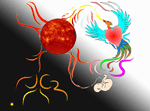« Childhood has its own ways
of seeing, thinking and feeling that are unique to it.
Nothing is less sensible than to want to substitute ours. »
Jean-Jacques Rousseau. |
The development of the moral sense
in the course of evolution.
1 – The child's moral sense :
We have seen how the moral sense of the very young appears, but before considering the paths taken by human thought in the field of morality, it is important to define what it is.A - What is morality ?
The notions of good and evil are familiar to us. They guide our judgements and actions, leading us to decide what can be done or condemned.This ability to distinguish between right and wrong is called moral conscience: it is not determined by what is, but by what ought to be.
The principle on which the moral conscience depends, and which imposes duties, must apply to all: its decisions are realised in action.
Although it seems to depend on education and traditions, moral awareness is not the result of blind obedience, but rather of freedom and individual responsibility.
Very often, certain values conflict, even though each is legitimate: this is the case of conscience.
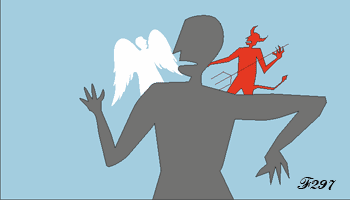
a – The morality of psychologists :
For a long time, psychologists were mainly interested in negative moral emotions, such as guilt and anger. They have seen morality as a response to regulate relationships between individuals and prevent them from doing wrong.
However, the fact that we can be so sensitive to the charitable acts of others even though we do not benefit from them is another aspect that needs to be taken into account.
b - Characteristics of morality :
The first characteristic of morality is that it has been selected by evolution.
We know today [cf : adn et mémorisation-in french] that memory is also transmitted genetically. It is therefore understandable that the "moral" sense can also be acquired and conserved through evolution, since it has advantages and allows adaptation.
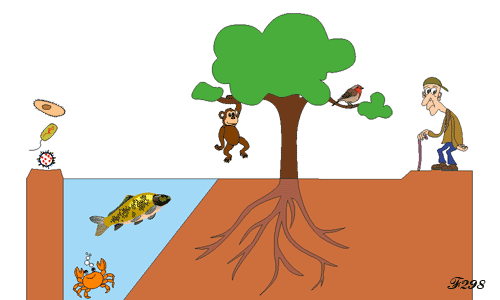
Biological adaptations in the course of evolution.
The second feature is evident from birth : the infant brain is organised to respond morally. During the first year, babies react to the moral aspects of a situation. The following year, capable of acting on their own, they spontaneously intervene to help others.
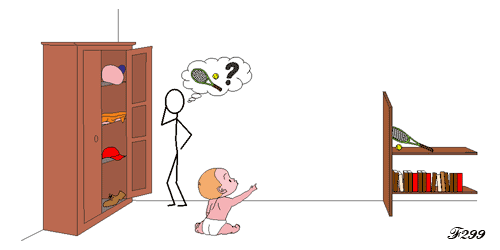
The third characteristic is that this capacity has become automatic in the course of evolution, and it escapes consciousness.
As a result, it becomes difficult to attribute philosophical justifications to it, such as legal or religious origins.
Indeed, justice does not tell us what rules to follow : it is because we are already rich in this moral sense that we feel the well-being and the discomfort that we create in others, and that we have developed a justice that sets the rules. These rules, normally useless for those who are able to feel the emotions and feelings of others, are indispensable for those who do not feel.
 |
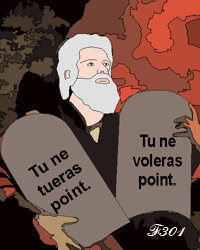 |
Feeling... |
...or obey ! |
« The loss of sensibility requires the establishment of rules. »
c - What is the difference between ethics and morals ?
For some thinkers, 'morals' and 'ethics' have the same meaning : the former comes from the Latin word 'mores' and the latter from the Greek word 'êthos', both meaning 'morals'.
For others, these terms are not equivalent. For them, morality refers to a set of values and principles that differentiate between right and wrong, and which should be adhered to.
Ethics, on the other hand, refers to an argumentative reflection with a view to doing the right thing. This ethical reflection takes place at different levels, from the study of its components to its practical aspect.
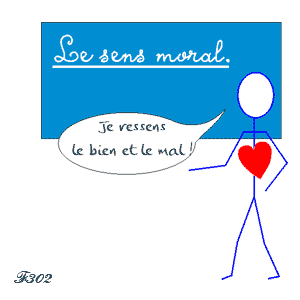 |
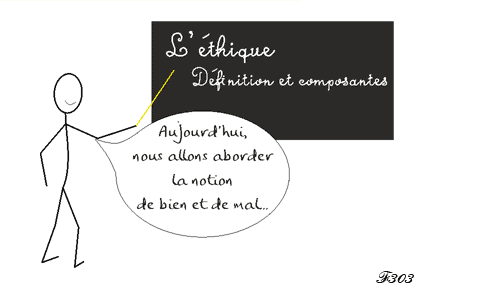 |
Once the 'correct' way to behave has been determined, rules can be formulated.
Thus, for a society it may be ethical to hunt animals or spray pesticides for the common good, while for individuals these same actions may offend their moral sense.
In short, morality is governed by values linked to emotions and feelings, whereas ethics defines acceptable or unacceptable behaviour through reasoning.
However, whatever the society, the time or the choice, feelings arise : they will be expressed through well-being, but also guilt, which can reorient future behaviour.
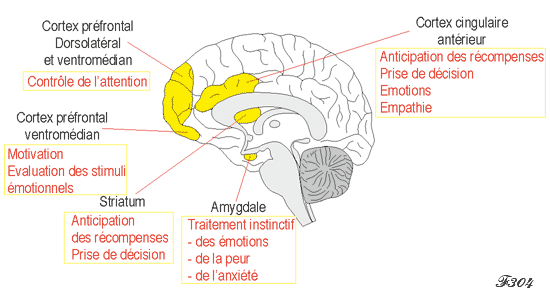 |
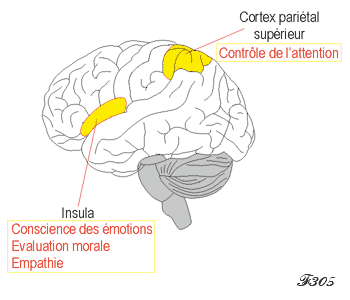 |
The moral sense in the brain.
d - Selfishness and altruism :
One of the main challenges facing human societies is to reconcile such contradictory imperatives as personal and collective needs, to which is now added respect for the environment.
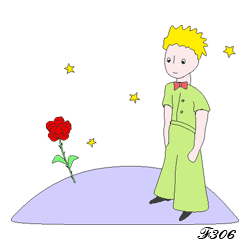 |
 |
The self. |
Others. |

The environment.
However, the reason why these imperatives are so difficult to reconcile is that they come down to a question of selfishness and altruism.
We have seen that the development of consciousness is inseparable from perception and the information received through the senses (vision, hearing, etc.) [cf : The building of consciousness-in french]. Sensitive perception is also at the origin of empathy, which allows us to feel what the other person is feeling, and of which one of the forms of expression, in community life, is compassion.
Without empathy, policy makers are unable to address growing inequalities.
Without altruism, economists and financiers can only be concerned with maximising their own interests.
The absence of empathy and altruism reveals a minimal awareness of the other: perhaps the equivalent of a virus that is only capable of feeding on its carrier and killing it, before disappearing.
Of course, we are not talking here about the physiological "egoism" which consists in respecting one's needs : in this case, the subject does not feel this pathological need for "more and more" which reveals an incoercible dissatisfaction.
 |
Feeling allows us to marvel at the world. |
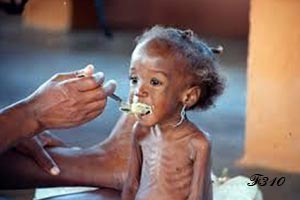 |
Feeling allows one to help. |
 |
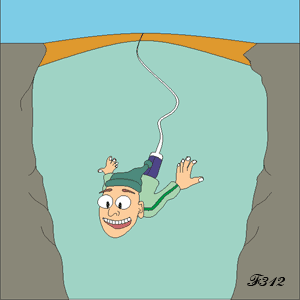 |
Few feelings impose a permanent race to possession and sensations. |
« Empathy is an indispensable component of consciousness.
In its absence, the perception of the other is non-existent. »
In its absence, the perception of the other is non-existent. »
e - Secondary components of morality : (guilt & self-evaluation - egoism & altruism)
Moral consciousness, in humans, implies the ability to feel good through the perception of well-being and the consequences of evil through a painful sensation : guilt.
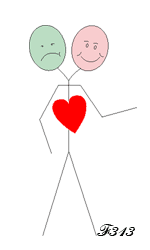
This particular feeling selected by evolution indicates that the individual is able to evaluate his own behaviour.
Indeed, brain imaging has shown that there are regions in the brain specifically associated with guilt. These regions overlap with areas that allow for the self-assessment of behaviour.
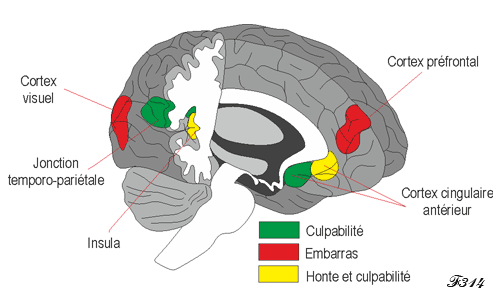
This feeling of guilt is an indicator of psychological and moral balance, important in social relationships.
If we have seen that the small child seems naturally inclined towards what is good", i.e., in the first place, good for him or her, in the adult who possesses a "moral conscience", the evaluation of his or her acts is also done according to the group to which he or she belongs. It is no longer just a matter of feeling for oneself but also of feeling in relation to others.
 |
 |
In doing so, it helps to strengthen social relationships in several ways :
– Firstly, it allows us to show others that we feel at fault for having caused them harm, and that we regret having done so. It helps to renew the broken relationship, which is not the case with shame.
– It also allows us to anticipate how we will feel when we act:
Like physical pain, it alerts us and prevents us from behaving badly.
- A strong sense of guilt often leads to altruistic behaviours to reduce the intensity of this feeling.
The guilt that comes from empathy, i.e. the ability to feel what the other person is feeling, is developed in particular through parenting: children whose parents are very close to them emotionally are more likely than others to feel guilt when they hurt someone.
« The inability to evaluate oneself is revealed in both individual and collective behaviour.
Its first expression is selfishness. »
Its first expression is selfishness. »
B - The development of the child's moral sense :
Although researchers, such as Alan Laslie, a psychologist at Rutgers University in New Jersey, believe that our brains possess a theory of mind module from birth, it has been observed that adults have lost a significant part of their innate abilities. What are the causes of this ?a - Innate brain functions :
The brain functions conserved by evolution appear from birth and develop spontaneously as the child interacts with its environment.
Thus, as we have seen [cf : Moral Competence], as early as 6 months of age, the child prefers good guys to bad guys, which is the basis of a behaviour based, in this case, on personal well-being.
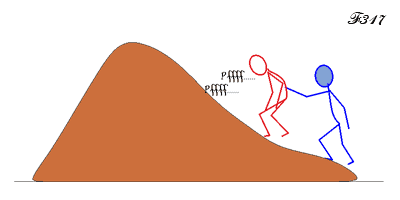 |
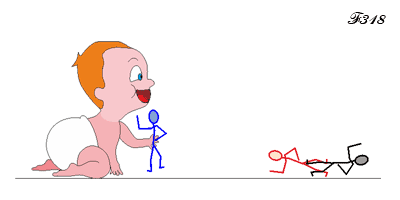 |
Kindness... |
...directs preferences ! |
It is also towards the reality of the things around it that it focuses its interest. We have seen that the first function of the brain is to recognise reality, even if contesting it later on does not exclude its recognition [cf : Evolution of consciousness-in french].
Would education or the example set by adults reorient these functions ?
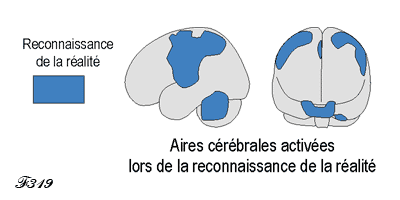 |
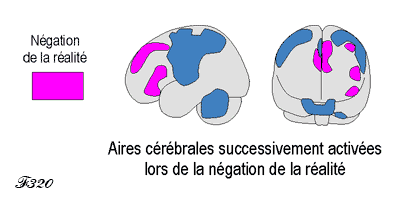 |
We have seen that most of the child's cerebral development takes place before the age of four, and that he possesses, from birth, surprising capacities that enable him to apprehend his environment very quickly. One of his capacities, even more astonishing, will enable him very quickly to integrate into a group, and above all to be welcomed with benevolence: this is his moral sense.
For the adult, whose thinking is influenced by his or her cultural environment, the understanding of this sense and its origins escape him or her: it seems to be first and foremost the result of learning, unless it is attributed a divine origin.
In general, morality is conceived as a construction of principles and norms that meet the needs of society, and our decisions are said to be the result of our deliberations.
Yet there are moral issues that fall outside this definition.
Jonathan Haidt, an American social psychologist and professor of ethics, has shown that stealing would be recognised as a bad action, even if there were no law recognising it as such, nor punishing it. Conversely, there are reprehensible behaviours that can be justified: for example, lying with good intentions.
For the researcher, the understanding of this meaning in the child comes up against the language barrier, and it is rather his actions that he must observe. Fortunately, the child's natural spontaneity and reality orientation are a great help.
b - The evolution of the moral sense :
A growing number of researchers (psychologists, biologists, and anthropologists), consider morality above all as an adaptation dependent on social life, without denying its innate character.
It thus allows man to collaborate even if his immediate interests are not satisfied.
Until 1990, to determine the moral stage reached by the child, psychologists told the child stories with moral dilemmas. Then they asked the child to explain why this or that action was moral, because what mattered to them was not the answer given, but the reasoning that led to the answer, which depended on language.
Today, the focus is on the emotional response, which profoundly renews previous certainties.
Whereas until the last century, babies and children were considered amoral or even immoral, in recent decades a great deal of research has challenged these assertions and transformed our understanding of moral development.
Indeed, outside of any reasoning or lived experience, babies are revealed to have highly complex emotional moral dispositions.
1 - Moral judgement and fairness :
We have seen the choices that the baby can make between good and bad, did not Rousseau write in "Emile ou de l'éducation" "There is therefore at the bottom of souls an innate principle of justice and virtue"? However, the child's choices can be much more complex.
Indeed, some experiences seem to validate the orientation of his moral sense towards the 'good', but other experiences show, for example, that it is just as acceptable for him to cause harm to someone who has caused it himself. This choice marks a shift from the simple evaluation of behaviour to a judgement of fairness. A behaviour that can be found in ancient texts, set out in the Law of Talion.
In 2011, Marco Schmidt from the Max Planck Institute in Leipzig and Jessica Sommerville from the University of Washington in Seattle observed the manifestation of this sense in children as young as 15 months: they are surprised if a cake is divided unequally between two puppets.
The fair share is what they expect.
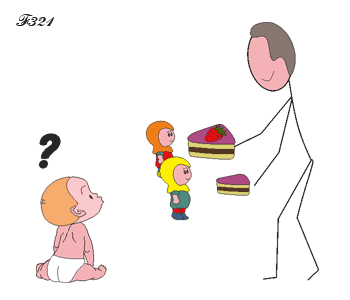
By the age of 2 or 3, most moral judgements are in place in all societies, suggesting that this sense may not only be innate, but also universal.
How is this sense exercised in adults? Does community life influence it?
To understand it, researchers have no shortage of imagination and they are brilliant storytellers.
Thus the following story was proposed to thirty or so subjects, varying the price that the main character had to pay for his help.
"John is taking a quiet walk in the countryside when he hears screams. He then discovers a house in flames. Inside, five people are locked up. Does John have a duty to intervene ?
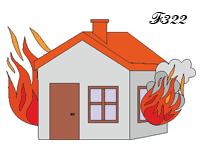
This intervention will have consequences for him, which he will have to assess and which will determine his choice. If he enters the house :
- he will only be slightly burned,
- he will be seriously burned and will suffer for several months,
- he will be disfigured,
- he will pay with his life.
The results show that only the first proposal leads to everyone agreeing with the duty to rescue.
On the other hand, most of the participants considered that John could not be blamed for not saving five people if his own life was at stake.
The moral judgement thus appears to be the result of a calculation that tends to balance the interests of each person, the duty not being to sacrifice oneself for the good of others, but to help while respecting one's own interests.
This is a natural compromise between altruism and egoism, which has two advantages:
- it respects the other person while at the same time protecting his or her interests,
- Moreover, the immediate sacrifice that one imposes on oneself within the limits of what is possible opens up prospects for later profit (reward or admiration).
Indeed, in a community, the most selfish individuals, who take too large a share of the benefits, may be pushed aside in favour of more generous individuals.
Conversely, those who give others more than they need may be exploited by their partners and find themselves disadvantaged.
However, this self-care, which limits the negative consequences of altruism and opens up prospects for community benefit, is by no means an absolute rule.
« Moral judgement is the result of a compromise between altruism and selfishness,
It tends to balance the interests of each. »
It tends to balance the interests of each. »
2 – The logic of merit :
Gradually, as children grow up, they make more and more nuanced use of fairness.
Experiments designed to study the development of this sense were first conducted in situations where the child was a spectator.
Thus, in line with the logic of merit, which implies that rewards should be adapted to the effort accomplished, at the age of 21 months, children expect the distribution of rewards to be unequal when one of the two puppets has done all the work.
In 2012, Nicolas Baumard of the École Normale Supérieure in Paris showed that 3-year-olds take merit into account: they give the larger of two cakes made by two girls to the one who has done the most work.
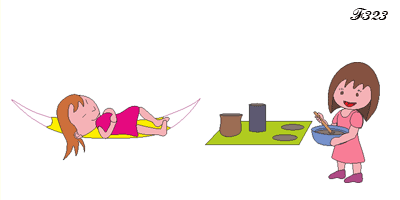 |
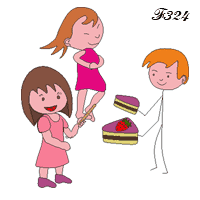 |
In 2012, Katarina Harmann and her colleagues at the Max Planck Institute in Leipzig confronted three-year-olds with different conditions when they were placed in front of a device that distributed rewards.
– Control condition : two children are faced with unequal sharing from the start (one receives 3 rewards, the other only one).
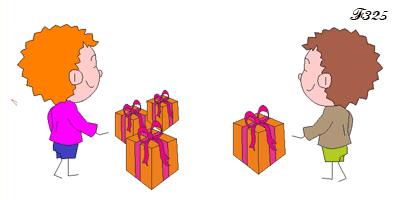
– Parallel working condition : independently of each other, each has to pull on a rope to make rewards fall from the machine.
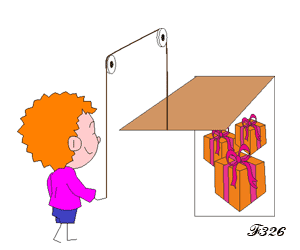 |
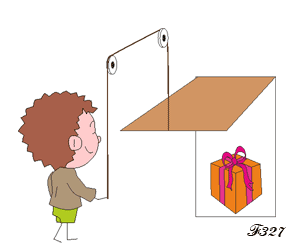 |
Quand les enfants tirent sur la corde, trois récompenses tombent d’un côté et une seule de l’autre.
When children pull on the rope, three rewards fall on one side and only one on the other.
Most 3 year olds then spontaneously give one of the 3 rewards, or let the other child take it... but they only do this if they have previously cooperated.
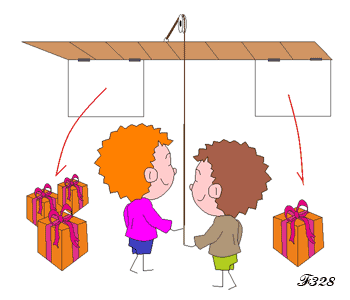 |
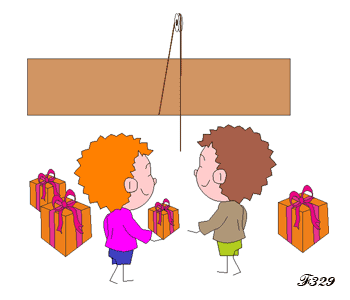 |
Shared reward.
This is rarer when they act in parallel, and almost never happens when sharing is done from the start.
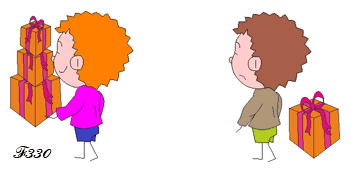
Reward retained.
This result is consistent with the hypothesis that a sense of fairness is the consequence of an evolution from individualistic behaviour to cooperation.
Thus, from birth, even though the child's 'moral sense' is primarily self-interested, the child is willing to interact with and help others. However, as this sense is not yet mature, it will evolve according to parental example as well as community experiences.
Like the ability to learn language, morality is a biological predisposition whose expression will depend on the cultural environment.
« The child is naturally ready to interact with others and share. »
3 - Selfless help and preferences :
From the end of the first year, the young child shows a natural inclination to help others (study by Felix Warneken and Michael Tomasello of the Max Planck Institute in Leipzig).
For example, he will spontaneously help someone who is looking for an object whose location he knows, by indicating its location with his finger.
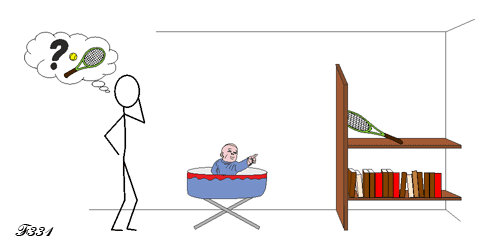
Two months later, he will spontaneously help an adult who cannot pick up a fallen object. As soon as he can, he will even open a wardrobe door if the adult's hands are caught.
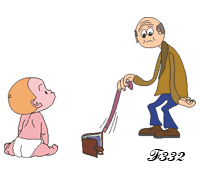 |
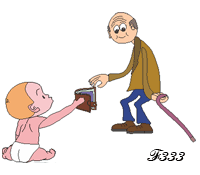 |
A number of experiments have observed the child's early choices, their preferences for 'nice', but especially their preferences for cooperation.
In 2007, in order to observe and understand babies' reactions, choices and preferences, Kiley Hamlin, Paul Bloom and Karen Wynn from the Yale Institute's Baby Commissioning Laboratory tested them with short moral scenes.
In the first experiment, children aged 9 and 12 months see a yellow triangle helping a red disc up a hill, then a blue square opposing its ascent.
 |
 |
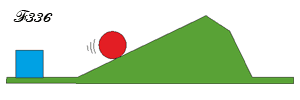 |
 |
It can be seen that the babies look longer at the second situation which intrigues them.
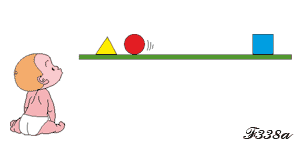 |
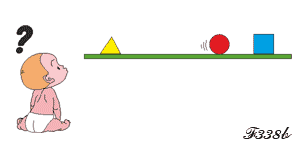 |
In another experiment, this time with animal puppets, children aged 5 and 9 months were given the choice between two puppets that had helped or hindered the action of a third: the majority of babies preferred the puppet that had helped.
Finally, the researchers offered a neutral puppet in the choice: the children preferred the prosocial puppet to the neutral one, and the neutral one to the antisocial one.
Other experiments were able to demonstrate this predisposition from the age of 3 months.
Gradually, the behaviour will continue to evolve and the child will start to show strategy: at 8 months, he will no longer only prefer the good guy, but will also choose the character who "punishes" the bad guy, thus showing that he takes into account not only the valence of social actions, but also their context.
Japanese Red Cross video :
children, even shy ones, alert adults.
PS: aligatô = thank you.
children, even shy ones, alert adults.
PS: aligatô = thank you.
« The child is naturally ready to interact with and help others. »
All of these behaviours are based on an essential capacity, empathy, i.e. the ability to feel what the other person is feeling.
c - Empathy, source of moral sense :
1 – Empathy, social cement :
In the 1970s, studies showed that empathy is present, from birth, in a rudimentary form: resonance (the baby cries while listening to the cries of other babies [cf : imitation]). Its maturation is very rapid : toddlers are precociously concerned with the well-being of others, a biological predisposition at the basis of the construction of morality.
Moreover, feeling what the other feels could appear much earlier, even while he is in his mother's womb : bathed in the molecular environment of her emotions, he shares, without yet being able to give it a meaning, the experience of this other who gives him life.
It is around the age of 18 months that this capacity will reach maturity.
One is in empathy when one feels what the other is feeling (or what one can estimate that he or she is feeling in the given situation), and what one feels then gives rise to an affective response to the feelings of the other.
However, the emotions perceived are not always the same, they can be oriented by one's own inner experience: one can, for example, feel empathetic anger when seeing someone attacked, even if it is fear that the latter is experiencing.
Various studies have shown that the perceived distress leads inevitably to help : the greater the suffering of the victim, the more urgent the need to help.
Moreover, if the intensity of the victim's perceived distress decreases, the helper feels better, which is not the case if he or she has remained passive or if, despite his or her efforts, the victim's distress has not been relieved.
Thus, empathy-based assistance, by relieving the victim's distress, also soothes the rescuer.
This is why empathy, by allowing the feelings of others to be shared, proves to be a social cement.
Conversely, the inability of someone to feel the suffering they cause others (hurtful humour or the murder of loved ones) can put them in a position of great danger.
« If empathy is a social cement,
its absence can be destructive for oneself or for the other. »
its absence can be destructive for oneself or for the other. »
2 - The 5 modes of empathic activation :
There are five modes of activation of empathy :
Three are preverbal, they appear in the child before he is able to express himself vocally. They are :
– mimicry,
– conditioning,
– direct association,
The other two are language-mediated association and perspective taking.
Mimicry was described more than two centuries ago by Adam Smith, a Scottish philosopher: "the crowd, when watching a tightrope walker on a flexible rope, tends to reproduce the tightrope walker's balancing movements.
Closer to home, horror films and other thrillers make us stiffen up in our seats, ready to react as soon as any danger to the character we like arises.
Conditioning occurs when a child observes someone in distress and experiences that feeling at the same time. For example, the anxious mother will transmit her state of bodily tension to her baby as she holds him.
Direct association, similar to conditioning, does not involve speech.
If the child sees another child cut himself, the sight of blood will remind him of the day he hurt himself.
The infant's primitive form of empathy differs from mature empathy, which requires an awareness that what one feels is a reaction to the distress of another.
This development depends on the acquisition of language that allows us to understand what is being felt.
Les 2 autres modes d’empathie ne sont pas transmis par les sens.
The other two modes of empathy are not transmitted through the senses.
In mediated association, the victim's distress is communicated through language: the message that language delivers becomes the intermediary between what the victim feels and the empathic response of the listener.
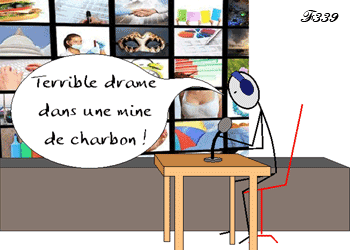 |
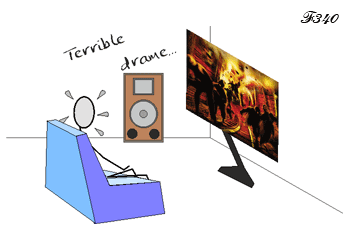 |
In the absence of visual confirmation, emotional responses may be attenuated (if the observer has not had an identical experience), or even distorted (manipulation by language).
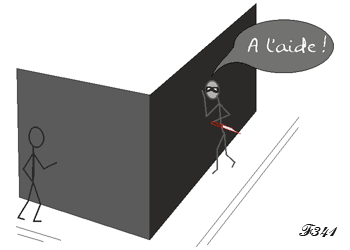
Perspective-taking consists, despite the distance, in putting oneself in the place of another person and imagining what he/she feels.
In the case where the perspective is centred on the other person, one imagines what the victim is feeling.
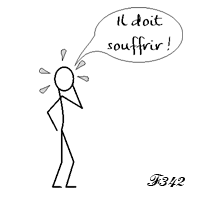
In the case where the perspective is self-centred,, one imagines how one would feel in another's situation.
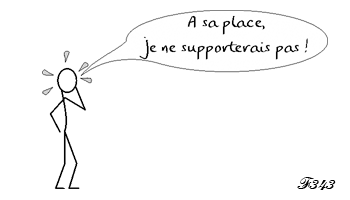
It has been shown that self-centredness triggers a more intense emotion because it brings back memories of one's own past.
On the other hand, measures of empathic response have been found to be closer in homozygotic twins (from the same fertilised oocyte) than in dizygotic twins (from 2 oocytes), suggesting that empathy has a hereditary component.
Unlike adults who are aware of their empathic feelings, children do not yet have this awareness. In order for them to be able to distinguish between themselves and others, they must first acquire the notion of their own identity.
Its development will take place in six stages, identified by Martin and Hoffman, psychology professors at New York University.
« The notion of one's own identity is the prerequisite
to mature empathy. »
to mature empathy. »
3 - The six stages of a child's empathic development :
– The 1st stage is represented by resonance. An infant cries as soon as he hears another cry. He therefore responds to an emotion by reproducing the same emotion.
– The 2nd stage is "egocentric" empathic distress. It occurs around the age of 11 to 12 months : babies' responses are more complex: they cry, may also moan or look at the victim in silence.
The baby behaves as if someone else's misfortune is happening to him or her personally, and seeks consolation.
- The third stage is the almost egocentric empathic distress.
From 14-15 months, the previous behaviours become less frequent, and the child begins to try to help the one who is suffering.
They now know that the other person is physically separate from them, and they no longer confuse the other person's distress with their own: if they act, it is really to help the other person. Moreover, this behaviour has an advantage: by calming the other person, he soothes his own feelings.
Indeed, while knowing that it is indeed the other who is in distress, he remains egocentric and his helping strategies are above all those that make him feel good.
This is how a 14-month-old boy whose friend is crying can take him by the hand and lead him to his own mother, even though his friend's mother is present.
- Stage 4 is proven empathy for the distress of others.
Real progress occurs at the end of the second year when the child recognises himself in the mirror. When he discovers a spot on his forehead, he tries to erase it by rubbing his forehead. Previously, they would have rubbed the stain on their image in the mirror. It is this new behaviour that allows us to consider that he has acquired self-awareness.
Shortly afterwards, the awareness that others have their own mental states (thoughts, feelings, desires) begins, and that these states are independent of his own, which makes him more able to help.
- The 5th stage, which begins around 9-10 years and lasts for the rest of life, is empathic distress beyond the situation.
The observer's feeling depends on the unfortunate circumstances of the victim: he or she will be more moved if the victim's sadness is a reflection of his or her life as a whole rather than the result of a particular event.
- Finally, the 6th stage is empathy for a distressed group.
Cognitive psychologists now believe that children discover moral norms in the course of social interactions that will lead them to coordinate their actions with those of others.
The way children are raised will contribute to the development of empathetic morality.
Paying attention to the distress of others helps to stimulate it, as does the example set by parents.
Authoritarian stimulation, on the other hand, triggers poor quality empathy and help.
In general, example will take precedence over oral learning.
« Individual well-being
depends on the well-being of others. »
depends on the well-being of others. »
4 - Is altruism disguised selfishness ?
Many theses have been put forward over the decades. Peter Blau, an American sociologist, defended the idea that the apparent selflessness of altruism was often motivated by the expectation of social benefits.
Anna Freud daughter of Sigmund Freud, argued that altruism was motivated by masochism.
For many, disinterested altruism would not exist : it would only be egoism in disguise.
The current debate has centred on the studies of two American researchers who both admit that the feeling of empathy felt for a person in difficulty generally leads to helping them. From there, their opinions diverge.
According to Daniel Badson (University of Tennessee), helping others is often altruistically motivated.
On the other hand, for Robert Cialdini (Arizona State University), the distress of others produces a feeling of unease in the observer, which he will try to eliminate. It would therefore be a selfish motivation to help.
To defend his thesis, Daniel Badson varied the level of empathy of subjects while they observed a young woman being subjected to electric shocks (fictitious, which the participants did not know). They were then asked to take her place, with the option of giving up after two shocks, or staying until the end of the experiment. While a number of subjects chose the easy option, many offered to take the victim's place, regardless of the conditions.
Other experiments have shown that altruism motivated by empathy does not serve to improve one's image or self-esteem.
It goes without saying that the assertion of a fundamental egoism is not defensible because it belongs to the realm of immunising theories as the epistemologist Karl Popper [cf : Causal theories-in french] has shown, for whom only a theory that can be refuted is scientific.
While it is undeniable that selfish motives can exist, the work carried out by D. Badson confirms his hypothesis that altruism based on empathy is genuine, and the scientific community today considers this thesis to be solid.
Proven altruism responds to the same logic of well-being that animates all living beings, well-being that is shared in social species. In humans, it shows that we are linked to others and that our well-being also depends on that of others.
« If altruistic acts are based on empathy
it is not selfishness, but true altruism. »
it is not selfishness, but true altruism. »
C - The importance of emotions :
a- Brain and emotions - Structures involved :Many brain structures have a specific role in behaviour and moral judgement. Some, such as the posterior cingulate cortex or the temporal sulcus, have fairly general functions: their role is to interpret the intentions of others.
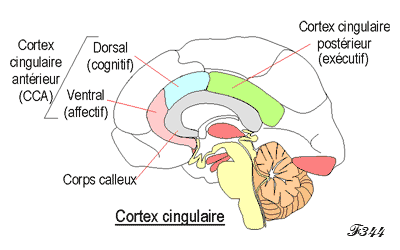 |
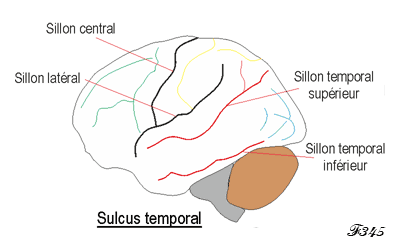 |
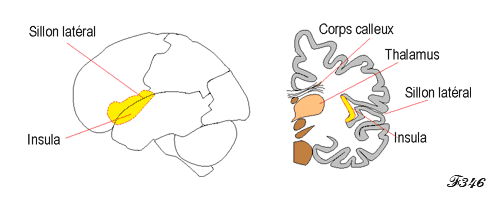
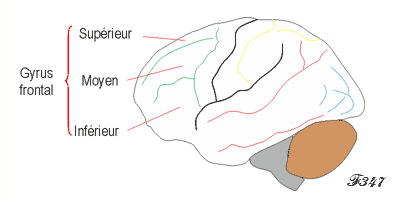 |
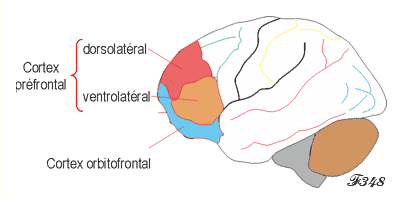 |
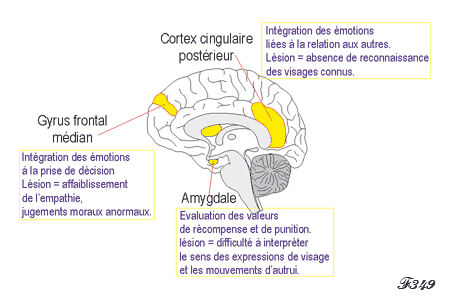 |
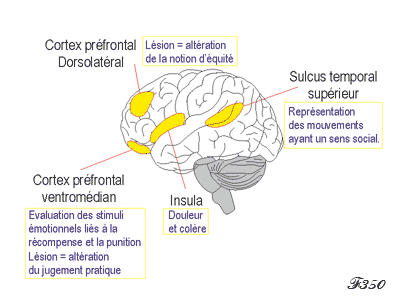 |
A first scenario illustrates the importance of the emotional reaction in the choice of actions :
The dilemma proposed is based on a choice: let five people die while conversing on a railway track, while a train is coming, or save them by pushing another one on the track.
The majority of the subjects chose the first option, without being able to justify their choices, while psychologists believe that there is an innate reluctance to harm others or members of one's own species.
Scientists, such as Joshua Greene (professor of neuroscience at Harvard University) in 2001, have observed the activation of several brain structures during this decision, in particular the cingulate cortex and the frontal gyrus.
In contrast, the same scenario, when presented to subjects with lesions of the ventromedial prefrontal cortex, resulted in the sacrifice of a single victim.
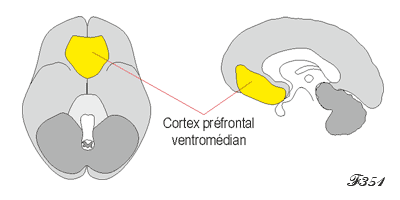
Selon Joshua Greene, lorsque cette région est endommagée, ce sont les informations fournies par le cortex préfrontal dorsolatéral, habilité à évaluer les coûts et bénéfices, qui prennent le dessus.
Another scenario illustrates the importance of emotional response in the experience of fairness [cf : Moral Competence and the Sense of Fairness]. Two players are asked to share an unequal amount of money. If one of them refuses, both lose everything.
Many players would rather lose everything than accept an unequal share.
In this case, the MRI reveals intense activation of the anterior insula. This brain area is also involved in the processing of anger and pain.
Innate emotions of aversion to injustice therefore appear to be integrated into behaviour and are dependent on information from the dorsolateral prefrontal cortex. If this region is neutralized, players are more likely to accept unequal shares.
b - Actions, intentions and emotions :
Many of our value judgements are not only about actions, but about intentions. This can be seen in everyday life as well as in court: a premeditated crime will be condemned more heavily than an involuntary homicide.
To answer this question, the following problem is proposed to a group :
1 - A woman called Grace makes coffee for her friend Rosy with the intention of poisoning her. She makes a mistake and puts sugar instead of poison.
2 - Another woman, Beth, also makes coffee for Rosy. Thinking she is putting sugar in it, she pours in poison: Rosy dies.
Which of the two women is more reprehensible ?
Nine of the subjects in the experiment had significant damage to the ventromedial prefrontal cortex, seven had other brain damage and eight were unaffected.
The patients with prefrontal cortex damage were the only ones to judge Grace as less culpable than Beth: the outcome (Rosy is alive), therefore, counted more than the intention to kill. On the other hand, they considered Beth's involuntary but fatal act more guilty.
In this case, moral judgement is impaired, which is the result of an emotional deficit: as we cannot associate the intentions of others with positive or negative feelings, only the evaluation of the consequences determines the judgement.
Emotions thus play a decisive role in our moral evaluations, and are regulated by the ventromedial prefrontal cortex.
However, there are cases where the role of emotional reactions is unconvincing.
Indeed, the "killer train" dilemma leads to different results depending on whether the subject is personally involved in the action or not.
For example, when the subject just has to act on a switch to direct the train onto the victim instead of pushing the victim onto the track himself, his response is identical to that of the injured subjects: he sacrifices him. It seems, in this case, that the use of a tool establishes a distance between the motor action and the emotion. This distancing can be found in pilots carrying out an air strike: the objective takes little account of the presence of human beings.
The same is true when we ask whether or not a mother has the right to strangle her baby at birth simply because it suits her: the high rate of negative responses is the same for all subjects, whether or not they are harmed. In this case, it is the thought that establishes the distance: imagining the response has nothing to do with actually carrying it out.
However, these neuropsychological experiments are limited to two kinds of behaviour: one that consists of not physically harming others, and the other that consists of being fair or unfair in the distribution of a good. Although they allow us to understand the mechanisms at play and the innate bases of moral behaviour, they are not very good at defining human morality, which is entangled in its contradictions, as we shall see later.
c – Role of emotions in the adult's moral sense :
1 - Loss of emotional control :
In 1994, A. Damasio studied the case of Phineas Gage, a worker whose frontal cortex had been partially destroyed by a metal bar, and whose behaviour had become unstable even though his reasoning abilities were preserved.
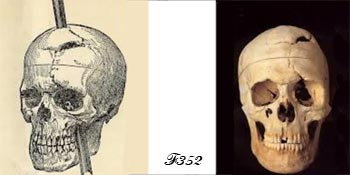
Similarly, one of his patients, nicknamed Elliot, who underwent surgery on the prefrontal lobe of the brain, showed similar symptoms : a disorganised material and emotional life, despite an intact reasoning capacity.
The prefrontal cortex is a region of the brain that is largely connected to the limbic system, which is known to activate a range of emotions, both positive and negative.
In the case of these two subjects, we can consider that their social maladjustment resulted from a loss of control over their emotions, a control which until then had allowed them to regulate their individual and instinctive reactions to adapt to the interrelationships linked to life in a community.
However, the adaptation to life in society in gregarious animal species has imposed this control. For example, whereas the isolated individual will feel the need to eat when he is hungry, i.e. at his own time, the individual living in a community will have to temporarily renounce this instinctive need: his pleasure will then be to sit down to eat with his friends or work colleagues at a predefined time.
It is not only the lesion of the cerebral areas that leads to disorders, but also fatigue, which can be sufficient to alter judgement.
Another study, for example, showed that guilt is reduced when people are tired.
In this study, volunteers were asked to watch videos that were emotionally difficult to watch.
Knowing that inhibiting emotions requires an intense effort of control, some were allowed to express them, while others had to inhibit them.
Then, a feeling of guilt was induced in all participants by a game in which, each time they failed to perform a requested task, a partner was given painful electric shocks.
The results showed that the exhausted participants felt less guilt about making their partner suffer than the participants who had not had to control themselves.
Language also plays a role in mental manipulation: guilt can be used to influence the behaviour of others.
2 - Voluntary control of emotions :
Voluntary brain control has been demonstrated by brief training sessions in which the subject strives to strengthen or reduce the activity of his insula. [We have seen that the insula is a key area for creativity and emotional perception. It generally allows simple and immediate reactions, most of the time perfectly adapted to the management of unexpected situations. However, it remains subject to the control of the frontal regions of the brain].
For example, five 30-second training sessions are sufficient to reduce its activity: subjects then experience fewer negative emotions when they see distressing images.
Conversely, a short training session in which the subject tries to increase the activity of his insula makes him more sensitive to hostile stimuli.
Change is therefore possible, in either direction... If the child who is subjected to the situation adapts innately, the adult can obtain the same result by using his will and his capacity for control.
Above all, the element that will determine the orientation of the child's moral capacities is emerging: his environment and education will be decisive in developing his sensitive nature, or on the contrary in making him cold and calculating.
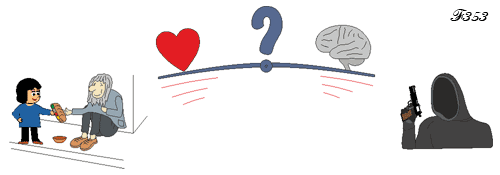
Two mechanisms that we know well therefore appear to be in competition: the heart, symbol of emotions and compassion, and reason, which is above all calculating.
3 - The failure of moral judgements :
Two studies have established how the brain makes moral judgements, and how these judgements can fail.
Liane Young and her colleagues from the Department of Psychology at the University of Cambridge (Massachusetts - USA), have identified an area of the brain that makes it possible to distinguish between an intentional crime and an accidental crime.
This is a brain area called the temporoparietal junction. If this area is blocked, moral judgements become aberrant.
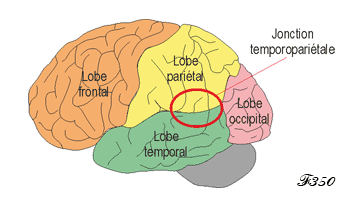
To achieve this result, and after inhibiting the subjects' temporoparietal junction, the researchers used the two stories of Grace and Rosy described above (b - antagonism due to emotions)
These subjects then judged the first story to be acceptable: it was not a big deal that Grace wanted to poison her friend, since she could not do it.
This study, put in parallel with that of Antonio Damasio's team at the University of Los Angeles (see: 1 - Loss of control of emotions), made it possible to understand the role of these regions:
- The temporoparietal junction allows Grace to know that the powder poured into her friend's coffee is poison. It emphasises the will to kill.
- The ventromedial prefrontal cortex adds an emotional dimension to this information; without this dimension, having the intention to kill is not condemnable as long as the person does not die.
4 – Morality between reason and emotion :
At a time when emotions were little taken into account, the results obtained by the American psychologist Lawrence Kohlberg tended to show that men on average reach a higher level of moral development than women.
However, this theory, which comes under the heading of cognitive psychology, is primarily concerned with reasoning, leaving aside the study of emotions.
The American psychologist Carol Gilligan argued that men's moral conceptions were based on principles, while women's were based more on their emotions. This view has become established with the work of A Damasio.
Emotions therefore appear to be indispensable in the establishment of harmonious human relationships.
However, they must be tempered by reasoning when they are excessive.
« Men and women appear complementary in the expression of their moral sense.
This complementarity is a strength if each is enriched by the other's abilities,
but often it can be a source of conflict
when it becomes a source of opposition. »
This complementarity is a strength if each is enriched by the other's abilities,
but often it can be a source of conflict
when it becomes a source of opposition. »
In conclusion of these reflections on the moral sense, we can consider that before the age of 3, the child has the capacity to access a moral sense adapted to both environmental and social conditions.
Can the primitive characteristics of this sense be found in species other than humans?
And why has this sense deteriorated so much in adult humans ?
This is what we will have to address in the coming chapters.
Next chapter :
2 - From the origins to the present day, the evolution of the moral sense : (continued)

